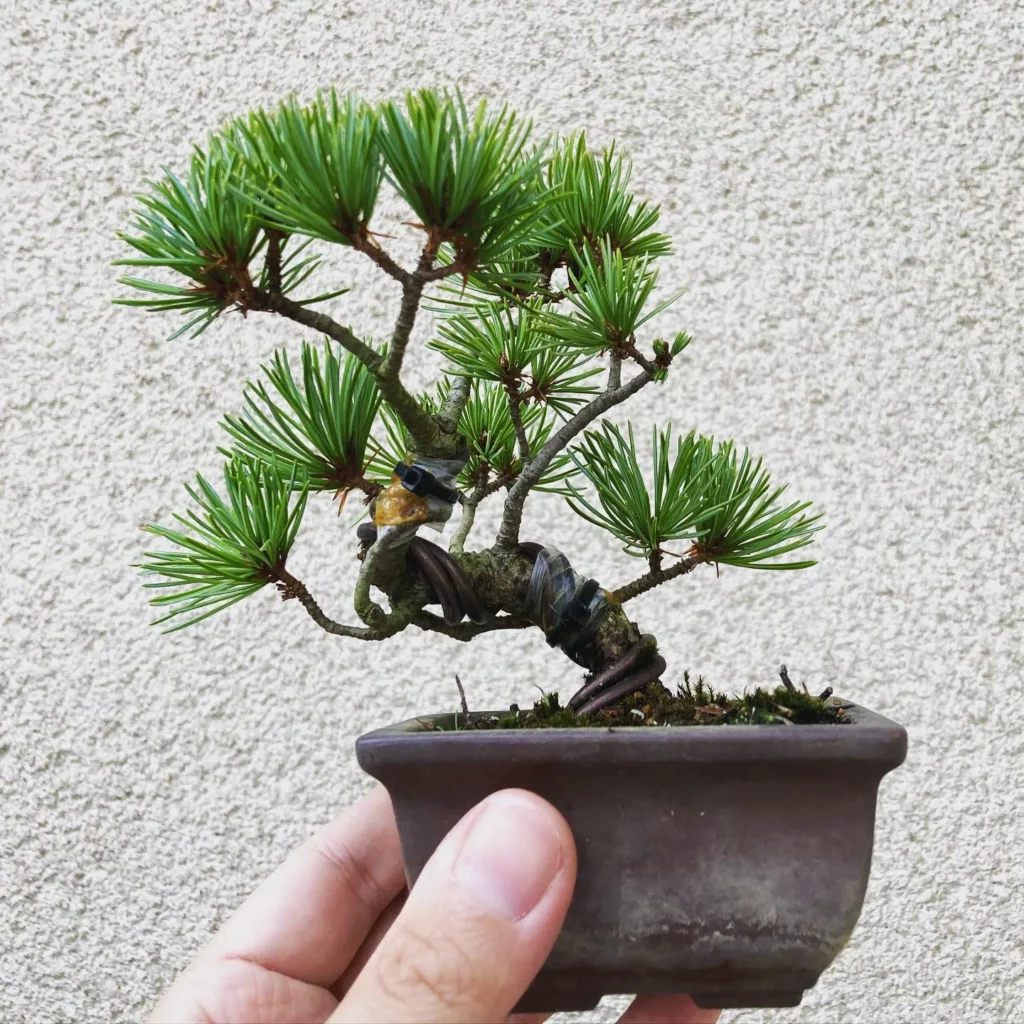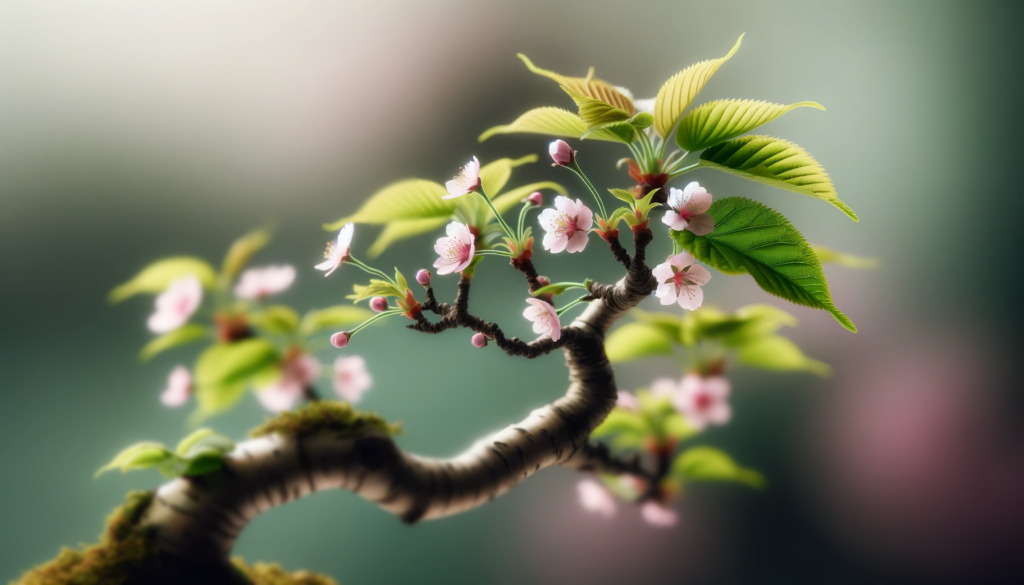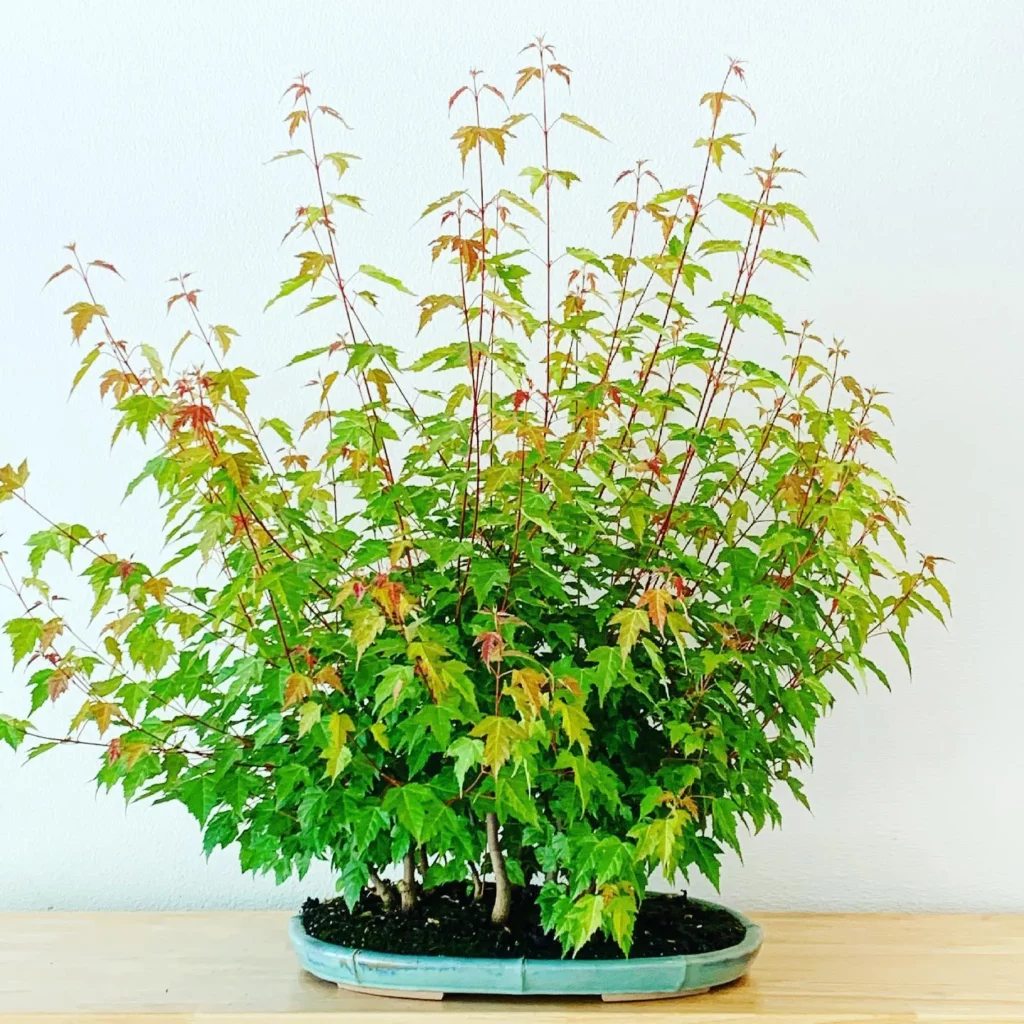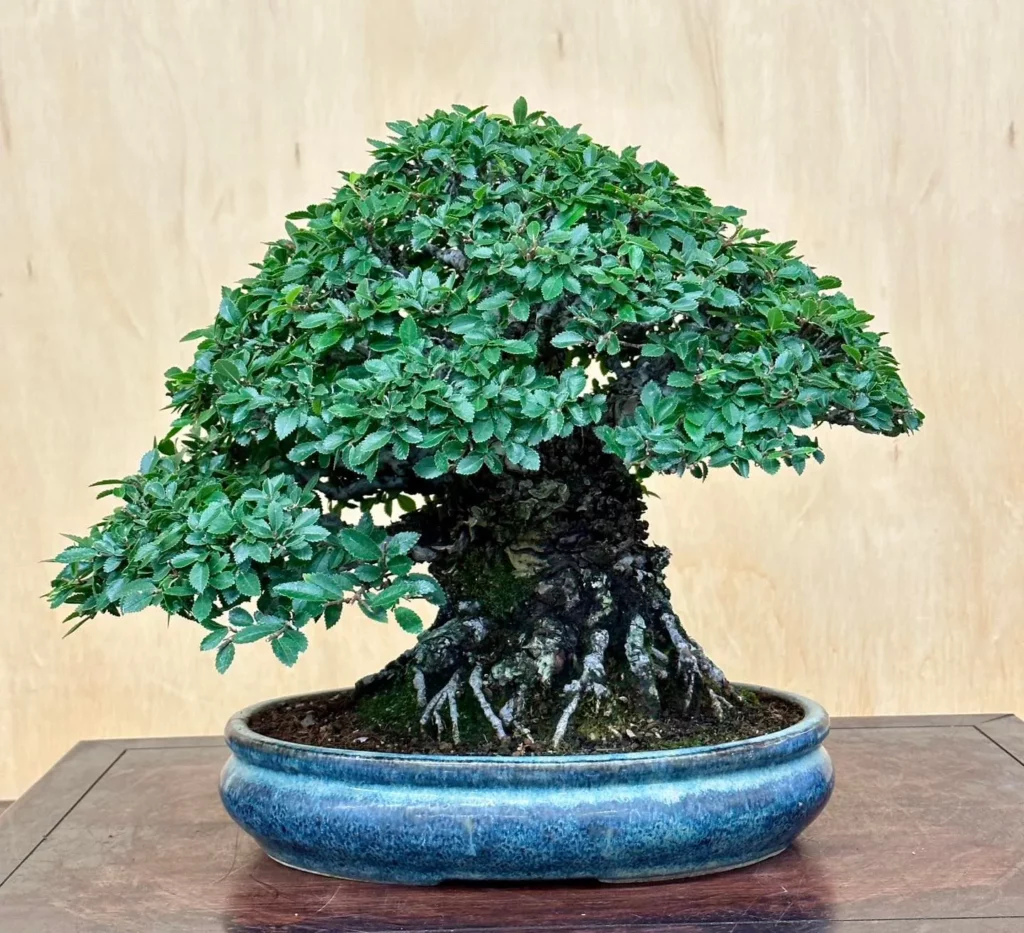European Beech Bonsai, also known as Fagus sylvatica, is a stunning bonsai variety that captivates with its beautiful appearance. This bonsai tree features vibrant green foliage that gracefully adorns its branches, creating a visually appealing display. The smooth grey bark of the European beech adds to its aesthetic appeal, providing a captivating contrast to the lush green leaves.
Key Takeaways:
- European Beech Bonsai, or Fagus sylvatica, is a popular choice for bonsai enthusiasts.
- It has beautiful trunks, vividly green foliage, and stunning autumn colors.
- European Beech Bonsai requires a sunny or semi-shaded position with good aeration.
Appearance of European Beech Bonsai



In addition to its striking appearance, European Beech Bonsai also offers a range of cultivars with unique characteristics. Some varieties showcase dark red foliage, adding a touch of drama to the bonsai’s overall look. Others have hanging branches, creating an elegant and cascading effect. There are even cultivars with deeply incised leaves, adding texture and interest to the bonsai’s foliage.
With its picturesque trunks and vivid foliage, European Beech Bonsai is a sought-after choice for bonsai enthusiasts who appreciate its unique charm and beauty.
Light Requirements for European Beech Bonsai



Proper lighting is essential for the healthy growth and development of your European Beech Bonsai. Here are some key considerations to keep in mind:
- Positioning: Place your bonsai in a sunny or semi-shaded spot outside. This will ensure it receives adequate sunlight for photosynthesis while also protecting it from excessive heat.
- Aeration: Good airflow is crucial for preventing fungal diseases and promoting overall tree health. Avoid placing your bonsai in areas with stagnant air or excessive humidity.
- Frost Protection: While European Beech Bonsai is frost-hardy, it is still important to protect it from severe frost when planted in containers. Consider moving your bonsai to a sheltered location or providing additional insulation during cold winter months.
Watering European Beech Bonsai



Proper watering is crucial for the health and vitality of European Beech Bonsai. Here are some important guidelines to follow:
- Water your European Beech Bonsai as soon as the soil starts to dry out. It should never be allowed to completely dry out, as this can stress the tree.
- Avoid overwatering, as excessive moisture can lead to root rot and other issues. It’s important to find the balance between keeping the soil moist and not waterlogging the bonsai.
- In winter, when the bonsai is in a dormant state, it is recommended to keep the soil slightly moist. This will help the tree survive the cold months.
- When watering, use clean, non-calcareous water. Avoid using water that is high in minerals, as this can cause mineral buildup in the soil over time.
Signs of Overwatering and Underwatering
It’s important to pay attention to the signs that your European Beech Bonsai may be getting too much or too little water:
- If the leaves start turning yellow or brown and feel limp, it may be a sign of overwatering.
- If the soil feels dry and the leaves appear wilted, your bonsai may be underwatered.
- Regularly check the moisture level of the soil by gently sticking your finger about an inch deep into the soil. If it feels dry, it’s time to water.
Fertilizing European Beech Bonsai



Fertilizing is an essential aspect of caring for your European Beech Bonsai. Providing your bonsai with the right nutrients will promote healthy growth and vibrant foliage. Here are some key points to keep in mind when fertilizing your European Beech Bonsai:
Fertilizer selection:
- Choose a balanced fertilizer specifically formulated for bonsai trees. Look for one with an NPK ratio of around 10-10-10 or 14-14-14.
- Organic fertilizers are also a great option as they release nutrients slowly over time, promoting sustained growth.
Application frequency:
- Fertilize your European Beech Bonsai every four weeks during the growing season, which is typically spring through summer.
- During the dormant period in winter, reduce or stop fertilization as the tree’s metabolic activity slows down.
Application method:
- Apply the fertilizer according to the instructions on the package. In general, it is best to dilute the fertilizer in water to avoid burning the roots.
- Apply the fertilizer evenly over the soil surface, taking care not to let it come into direct contact with the foliage or trunk.
Potting European Beech Bonsai
Proper potting is essential for the health and vitality of your European Beech Bonsai. Here are some important considerations when it comes to potting:
- Timing: Repot your European Beech Bonsai every two years in spring, before the new buds open. Older trees may require less frequent repotting.
- Soil Mix: Use a well-draining soil mix that provides good aeration for the roots. A mixture of Akadama, pumice, and lava rock or similar components works well for European Beech Bonsai.
- Root Pruning: During repotting, gently prune the roots to maintain a balanced root system. Trim any long or thick roots, and remove any dead or diseased roots. This will stimulate new root growth and promote overall health.
- Pot Selection: Choose a pot that is appropriate for the size of your bonsai. The pot should have drainage holes to prevent waterlogging. Consider the aesthetic appeal of the pot as well, as it can complement the beauty of your European Beech Bonsai.
How to Pot European Beech Bonsai:
- Carefully remove the bonsai from its current pot, taking care not to damage the roots.
- Gently loosen the root ball to separate the roots and remove any excess soil.
- Place a layer of fresh soil mix in the bottom of the new pot.
- Position the bonsai in the center of the pot, ensuring that it is upright and at the desired angle.
- Gradually fill the pot with the soil mix, making sure to distribute it evenly around the roots. Use a chopstick or similar tool to gently work the soil between the roots.
- Tap the pot lightly to settle the soil and remove any air pockets.
- Water the bonsai thoroughly to ensure good moisture distribution.
- Place your potted European Beech Bonsai in a suitable location, where it can receive the right amount of light and airflow.
Propagation of European Beech Bonsai
Propagation is an important aspect of European Beech Bonsai cultivation, allowing you to expand your collection and create new trees. While beech cuttings may not root easily and air-layering can be challenging, there are other methods you can try to propagate your European Beech Bonsai.
1. Seed Propagation:
Propagating European Beech Bonsai from seeds is a popular method. Collect fresh beech seeds in autumn and sow them in a well-draining soil mix. Keep the soil moist and place the pot in a cool, shaded area. The seeds will germinate in a few weeks, and you can transplant the seedlings into individual pots once they develop a few true leaves.
2. Hornbeam Cuttings:
If you’re looking for an alternative to beech cuttings, you can try propagating European Beech Bonsai using hornbeam cuttings. Hornbeam, a closely related species, has a slightly better success rate for rooting from cuttings. Take semi-hardwood cuttings in summer or hardwood cuttings in winter, around 6-8 inches long. Dip the base of the cuttings in rooting hormone and plant them in a well-draining propagation mix. Place the pot in a warm, bright area and keep the soil moist. With patience and proper care, the cuttings will develop roots and grow into new bonsai trees.
3. Grafting:
Grafting is another technique you can explore for propagating European Beech Bonsai. It involves combining a beech scion or cutting with a compatible rootstock. This method allows you to create new trees with desired characteristics or improve the vigor of a weak specimen. Grafting European Beech Bonsai requires skill and knowledge, so it’s recommended for more experienced bonsai enthusiasts.
Growth and Development of European Beech Bonsai
When it comes to the growth and development of your European Beech Bonsai, there are a few key factors to consider. Pruning plays a crucial role in shaping your bonsai and encouraging new growth. It is best to prune the tree in spring before the new buds open. By carefully trimming back branches and foliage, you can create the desired shape and promote a more balanced and aesthetically pleasing appearance.
Wiring can also be used to further shape and style your European Beech Bonsai. However, it is important to monitor the wiring closely to prevent wire marks on the smooth bark. Regular care and maintenance, including watering and fertilizing, are necessary to ensure the optimal growth and development of your bonsai tree. By providing the right balance of nutrients, light, and water, you can help your European Beech Bonsai thrive.
Key Points for Growth and Development:
- Prune your European Beech Bonsai in spring before new buds open to shape the tree.
- Monitor wiring to avoid wire marks on the smooth bark.
- Regular care and maintenance, including watering and fertilizing, is crucial for optimal growth.
- Provide the right balance of nutrients, light, and water to help your bonsai thrive.
Pests and Diseases of European Beech Bonsai
When caring for your European Beech Bonsai, it’s important to be aware of the potential pests and diseases that can affect its health. By staying vigilant and taking preventive measures, you can keep your bonsai thriving and beautiful. Here are some common pests and diseases to watch out for:
Pests:
- Mealy Bugs: These small, white insects can cluster on the leaves and stems, sucking the sap from the plant. Use an insecticidal soap or neem oil to treat infestations.
- Powdery Mildew: This fungal disease appears as a white, powdery coating on the leaves. Improve air circulation and avoid overhead watering to prevent powdery mildew.
- Scale: Scale insects are small, oval-shaped pests that attach themselves to the stems and leaves, causing yellowing and stunted growth. Remove them manually or use horticultural oil to control the infestation.
Diseases:
- Root Rot: Overwatering can lead to root rot, where the roots become waterlogged and start to decay. Ensure proper drainage and avoid overwatering to prevent this disease.
- Chlorosis: Chlorosis is a condition where the leaves turn yellow due to a lack of chlorophyll. This can be caused by nutrient deficiencies or improper pH levels in the soil. Adjust the fertilizer and pH as needed to prevent chlorosis.
Conclusion
Congratulations on reaching the end of our European Beech Bonsai beginner’s guide! We hope that you have found this comprehensive overview helpful in understanding the care and cultivation of this stunning bonsai variety. By following the guidelines and tips provided, you can successfully grow and maintain your own European Beech Bonsai.
Remember, the appearance of the European Beech Bonsai with its beautiful trunks, vibrant foliage, and captivating autumn colors will surely bring joy and satisfaction to your bonsai collection. Pay attention to its specific light requirements, watering needs, and regular fertilization to promote healthy growth and development.
Proper potting, propagation, and pruning techniques are also essential in maintaining the overall health and vitality of your bonsai. Be aware of common pests and diseases that may affect your European Beech Bonsai, and take necessary measures to prevent and control them.
With patience, dedication, and the knowledge gained from this beginner’s guide, you can embark on an exciting journey of cultivating your own European Beech Bonsai. Enjoy the beauty of this bonsai variety and the satisfaction of nurturing a living work of art.
FAQ
Can European Beech Bonsai be grown indoors?
European Beech Bonsai thrives in a sunny or semi-shaded position outside with good aeration. It is not recommended to grow them indoors as they require ample sunlight and fresh air for healthy growth.
How often should I water my European Beech Bonsai?
European Beech Bonsai should be watered as soon as the soil starts to dry out. It should never be allowed to completely dry out, but overwatering should be avoided. In winter, it is recommended to keep the soil slightly moist.
How often should I fertilize my European Beech Bonsai?
European Beech Bonsai benefits from regular fertilization. An organic fertilizer can be applied every four weeks during the growing season, or a liquid fertilizer can be used weekly. This will provide the bonsai with the necessary nutrients for healthy growth.
When should I repot my European Beech Bonsai?
European Beech Bonsai should be repotted every two years in spring before the new buds open. Older trees may require less frequent repotting. When repotting, make sure to use a suitable soil mix to ensure the bonsai’s overall health.
How can I propagate European Beech Bonsai?
European Beech Bonsai can be easily propagated from seeds. However, beech cuttings do not root easily, and air-layering is not always successful. Hornbeam cuttings have a slightly better success rate.
Should I prune my European Beech Bonsai?
Pruning your European Beech Bonsai in spring before the new buds open helps shape the tree and encourage new growth. Regular care and maintenance, including pruning, are necessary to ensure optimal growth and development.
What pests and diseases should I watch out for with my European Beech Bonsai?
European Beech Bonsai is prone to pests such as mealy bugs, powdery mildew, and scale. It is also susceptible to root rot and chlorosis if overwatered. Regular monitoring and appropriate treatment with specific pesticides can control infestations.
Can European Beech Bonsai be grown indoors?
European Beech Bonsai thrives in a sunny or semi-shaded position outside with good aeration. It is not recommended to grow them indoors as they require ample sunlight and fresh air for healthy growth.




